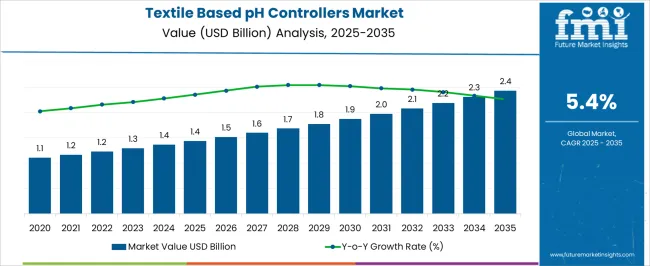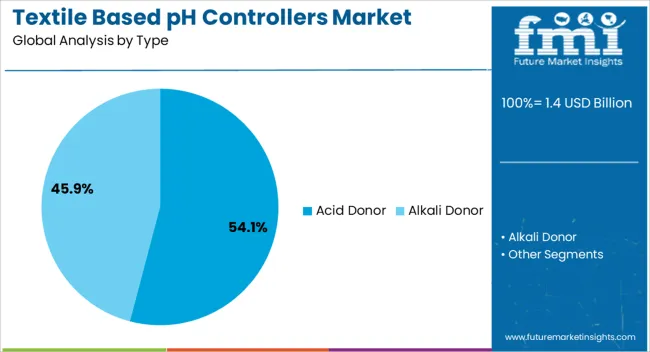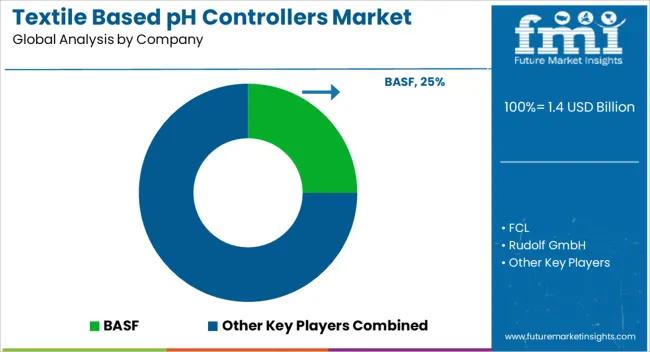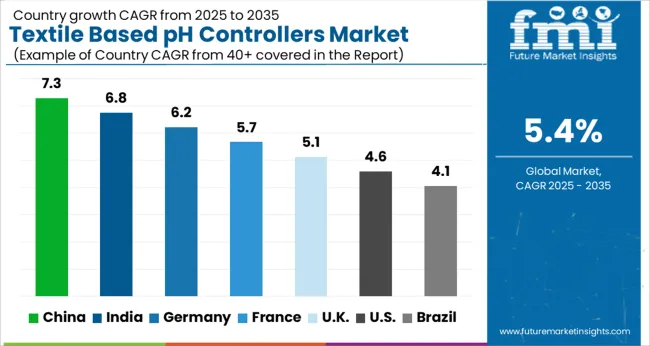The Textile Based pH Controllers Market is estimated to be valued at USD 1.4 billion in 2025 and is projected to reach USD 2.4 billion by 2035, registering a compound annual growth rate (CAGR) of 5.4% over the forecast period.

| Metric | Value |
|---|---|
| Textile Based pH Controllers Market Estimated Value in (2025 E) | USD 1.4 billion |
| Textile Based pH Controllers Market Forecast Value in (2035 F) | USD 2.4 billion |
| Forecast CAGR (2025 to 2035) | 5.4% |
The Textile Based pH Controllers market is witnessing steady growth, driven by the increasing adoption of process automation in textile manufacturing and the need for precise chemical management during production. The current market landscape is shaped by rising demand for consistent fabric quality, energy-efficient operations, and reduced chemical waste. In textile processes, maintaining accurate pH levels is critical to ensuring color consistency, material durability, and process safety.
Growing environmental regulations on chemical usage and effluent discharge are further encouraging the adoption of advanced pH controllers in manufacturing plants. Investments in smart manufacturing and Industry 4.0 initiatives are enhancing real-time monitoring capabilities, enabling automated adjustments to chemical dosing, which reduces operational errors and material wastage.
The market is also benefiting from the increasing focus on sustainable production practices, where precise pH control contributes to minimizing environmental impact Over the coming years, the integration of textile-based pH controllers with digital process management systems and IoT-enabled monitoring is expected to create significant opportunities for market growth, supporting scalability and efficiency in textile operations.
The textile based ph controllers market is segmented by type, process, and geographic regions. By type, textile based ph controllers market is divided into Acid Donor and Alkali Donor. In terms of process, textile based ph controllers market is classified into Bleaching, Stripping, Oxidation, Sourcing, Finishing, and Other Processes. Regionally, the textile based ph controllers industry is classified into North America, Latin America, Western Europe, Eastern Europe, Balkan & Baltic Countries, Russia & Belarus, Central Asia, East Asia, South Asia & Pacific, and the Middle East & Africa.

The Acid Donor type is projected to hold 54.10% of the Textile Based pH Controllers market revenue in 2025, making it the leading type segment. This dominance is attributed to its critical role in regulating pH during textile processes such as dyeing, bleaching, and finishing, where precise acidity levels directly impact fabric quality and consistency.
The widespread adoption of acid donors is facilitated by their compatibility with automated dosing systems, which allows continuous monitoring and adjustment without manual intervention. Additionally, acid donors provide predictable reactivity, enabling uniform color development and material stability, which are essential in high-volume textile production.
The growth of this segment has been reinforced by the increasing need for compliance with environmental regulations, as controlled acid dosing reduces chemical overuse and effluent pollution As textile manufacturers seek more reliable, efficient, and sustainable chemical management solutions, the Acid Donor type continues to lead the market due to its effectiveness, operational simplicity, and contribution to quality assurance in production processes.

The Bleaching process segment is expected to account for 41.70% of the Textile Based pH Controllers market revenue in 2025, positioning it as the largest application segment. The prominence of this segment is being driven by the critical importance of pH control in bleaching, where precise chemical regulation ensures fabric whiteness, uniformity, and fiber strength. Bleaching operations require consistent monitoring to prevent overexposure to chemicals that can damage textile fibers or compromise quality.
The adoption of textile-based pH controllers in bleaching processes allows real-time adjustments, reducing chemical consumption and ensuring environmental compliance. Increased demand for high-quality and sustainable textile products has further fueled growth, as manufacturers aim to minimize waste and improve operational efficiency.
The integration of automated pH control systems enhances process reliability, decreases production downtime, and supports scalable operations in large textile facilities As manufacturers continue to focus on efficiency, quality consistency, and eco-friendly practices, the Bleaching process segment is expected to sustain its market leadership through 2025 and beyond.
Growing demand for the textile based pH controllers has been observed from the textile industry. pH is the most important parameter to be maintained, in the textile processing industry.
Therefore, it is necessary to be regulated and controlled during various processes, to ensure the process efficiency, in textile manufacturing. The process effectiveness in primarily dependent on pH values, pH decides rate of reduction and oxidation, it also decides the quantity of textile chemicals used in the process.
Reactive dyeing process in textile processing is also primarily pH dependent. Therefore, for achieving the required results in the process, pH is the most important parameter to be controlled. Various chemical solutions are used for this purpose.
pH controllers are also known as pH buffers. Textile based pH controllers are majorly used in the process of dyeing in textiles manufacturing. Consistency in colors can be achieved by controlling and maintaining proper pH during the dyeing process.
Textile based pH controllers play a major role in all the liquid based processes in textile manufacturing. Therefore, the growth in the textile industry is expected to boost the demand for the pH controllers.
Textile Based pH Controllers Market Drivers
Textile based pH controllers are the part of textile auxiliary chemicals. Rise in demand for the textile auxiliary chemicals, for improving performance of the textile processing, has been seen in the textile industry. This is pushing the demand for the textile based pH controllers from this industry.
Increasing focus on the quality processes for getting high quality textile output, is pushing the use of textile based pH controllers during the textile processing. Increasing demand for textile chemicals due to rise in demand for textiles from apparels industry, is expected to drive the demand for textile based pH controllers. Innovations and development in the textile industry is supporting its growth, all over the world.
Textile recycling is also gaining more attention these days. Recycling of the textiles needs effective dyeing, which will in turn increase the consumption of the textile based pH controllers. High growth in demand for textile auxiliary chemicals and need for the pH controllers in the textile processing is expected to accelerate the growth of the textile based pH controllers during the forecast period.
Increasing capacities of textile plants in the emerging economies, is pushing the demand for high performance textile based pH controllers for the effective processing of textiles. This is projected to continue, over the forecast period. Increasing populations, has also accelerated the textile industry growth is resulting into rise in demand for textile based pH controllers.
Strong growth of global economy and increasing need for sustainable industrial solutions, is expected to boost the demand for textile based pH controllers globally, during the forecast.
One of the major challenge faced by the global textile based pH controllers market is need for the continuous research & development for the product improvement.
Large players in the market are continuously focusing on the innovations and developing improved textile based pH controllers. Therefore, to sustain in the global competition is one of the big challenges in the textile based pH controllers manufacturers.
Additionally, environmental regulations are getting stringent day by day, which may act as the restraining factor for the textile based pH controllers market during the forecast period.
New product development through the research & development has been observed in the market. Changing requirements of various industries posing the new opportunities for the textile based pH controller manufacturers. Different combinations of chemicals are being used for the better results on process efficiency.
Additionally, the manufacturers are signing long term contracts with the end users, for grabbing their market share. Strengthening the distribution channel for increasing the customer base, is also a focus of the key players in the market.
The global textile based pH controllers market is anticipated to be dominated by Asia Pacific region with China leading the market both in terms of production and consumption. India is also anticipated to witness fastest growth in demand for textile based pH controllers owing to the rapid growth in the demand for textiles auxiliary chemical, because of rise in the industrial infrastructure, for textile industry, in the country.
North America and Europe are collectively anticipated to hold significant share in the textile based pH controllers market and is expected relatively slow growth in demand compared to Asia Pacific.
Significant investments and recovering economy in Brazil and Argentina are projected to drive the Latin America textile based pH controllers market. Middle East and Africa is projected to witness moderate growth in demand for textile based pH controllers over the forecast period.

Some of the market participants identified across the value chain of global textile based pH controllers market are:
The research report presents a comprehensive assessment of the market and contains thoughtful insights, facts, historical data and statistically supported and industry-validated market data.
It also contains projections using a suitable set of assumptions and methodologies. The research report provides analysis and information according to market segments such as geographies, application and industry.
The report is a compilation of first-hand information, qualitative and quantitative assessment by industry analysts, inputs from industry experts and industry participants across the value chain.
The report provides in-depth analysis of parent market trends, macro-economic indicators and governing factors along with market attractiveness as per segments. The report also maps the qualitative impact of various market factors on market segments and geographies.

| Country | CAGR |
|---|---|
| China | 7.3% |
| India | 6.8% |
| Germany | 6.2% |
| France | 5.7% |
| UK | 5.1% |
| USA | 4.6% |
| Brazil | 4.1% |
The Textile Based pH Controllers Market is expected to register a CAGR of 5.4% during the forecast period, exhibiting varied country level momentum. China leads with the highest CAGR of 7.3%, followed by India at 6.8%. Developed markets such as Germany, France, and the UK continue to expand steadily, while the USA is likely to grow at consistent rates. Brazil posts the lowest CAGR at 4.1%, yet still underscores a broadly positive trajectory for the global Textile Based pH Controllers Market. In 2024, Germany held a dominant revenue in the Western Europe market and is expected to grow with a CAGR of 6.2%. The USA Textile Based pH Controllers Market is estimated to be valued at USD 533.4 million in 2025 and is anticipated to reach a valuation of USD 835.5 million by 2035. Sales are projected to rise at a CAGR of 4.6% over the forecast period between 2025 and 2035. While Japan and South Korea markets are estimated to be valued at USD 67.8 million and USD 46.4 million respectively in 2025.
| Item | Value |
|---|---|
| Quantitative Units | USD 1.4 Billion |
| Type | Acid Donor and Alkali Donor |
| Process | Bleaching, Stripping, Oxidation, Sourcing, Finishing, and Other Processes |
| Regions Covered | North America, Europe, Asia-Pacific, Latin America, Middle East & Africa |
| Country Covered | United States, Canada, Germany, France, United Kingdom, China, Japan, India, Brazil, South Africa |
| Key Companies Profiled | BASF, FCL, Rudolf GmbH, S&D, ZSCHIMMER & SCHWARZ, ICL, Seydel Companies, GIOVANNI BOZZETTO S.p.A., Jay Chemical Industries Ltd., Rung International, Avco chemicals, and Denim Care Sdn Bhd |
The global textile based ph controllers market is estimated to be valued at USD 1.4 billion in 2025.
The market size for the textile based ph controllers market is projected to reach USD 2.4 billion by 2035.
The textile based ph controllers market is expected to grow at a 5.4% CAGR between 2025 and 2035.
The key product types in textile based ph controllers market are acid donor and alkali donor.
In terms of process, bleaching segment to command 41.7% share in the textile based ph controllers market in 2025.






Our Research Products

The "Full Research Suite" delivers actionable market intel, deep dives on markets or technologies, so clients act faster, cut risk, and unlock growth.

The Leaderboard benchmarks and ranks top vendors, classifying them as Established Leaders, Leading Challengers, or Disruptors & Challengers.

Locates where complements amplify value and substitutes erode it, forecasting net impact by horizon

We deliver granular, decision-grade intel: market sizing, 5-year forecasts, pricing, adoption, usage, revenue, and operational KPIs—plus competitor tracking, regulation, and value chains—across 60 countries broadly.

Spot the shifts before they hit your P&L. We track inflection points, adoption curves, pricing moves, and ecosystem plays to show where demand is heading, why it is changing, and what to do next across high-growth markets and disruptive tech

Real-time reads of user behavior. We track shifting priorities, perceptions of today’s and next-gen services, and provider experience, then pace how fast tech moves from trial to adoption, blending buyer, consumer, and channel inputs with social signals (#WhySwitch, #UX).

Partner with our analyst team to build a custom report designed around your business priorities. From analysing market trends to assessing competitors or crafting bespoke datasets, we tailor insights to your needs.
Supplier Intelligence
Discovery & Profiling
Capacity & Footprint
Performance & Risk
Compliance & Governance
Commercial Readiness
Who Supplies Whom
Scorecards & Shortlists
Playbooks & Docs
Category Intelligence
Definition & Scope
Demand & Use Cases
Cost Drivers
Market Structure
Supply Chain Map
Trade & Policy
Operating Norms
Deliverables
Buyer Intelligence
Account Basics
Spend & Scope
Procurement Model
Vendor Requirements
Terms & Policies
Entry Strategy
Pain Points & Triggers
Outputs
Pricing Analysis
Benchmarks
Trends
Should-Cost
Indexation
Landed Cost
Commercial Terms
Deliverables
Brand Analysis
Positioning & Value Prop
Share & Presence
Customer Evidence
Go-to-Market
Digital & Reputation
Compliance & Trust
KPIs & Gaps
Outputs
Full Research Suite comprises of:
Market outlook & trends analysis
Interviews & case studies
Strategic recommendations
Vendor profiles & capabilities analysis
5-year forecasts
8 regions and 60+ country-level data splits
Market segment data splits
12 months of continuous data updates
DELIVERED AS:
PDF EXCEL ONLINE
Textile Coatings Market Size and Share Forecast Outlook 2025 to 2035
Textile Machine Lubricants Market Size and Share Forecast Outlook 2025 to 2035
Textile Transfer Paper Market Size and Share Forecast Outlook 2025 to 2035
Textile Waste Recycling Machine Market Size and Share Forecast Outlook 2025 to 2035
Textile Colorant Market – Trends & Forecast 2025 to 2035
Textile Recycling Market Analysis by Material, Source, Process, and Region: Forecast for 2025 and 2035
Textile Flooring Market Trends & Growth 2025 to 2035
Textile Tester Market Growth – Trends & Forecast 2025 to 2035
Textile Colors Market Growth - Trends & Forecast 2025 to 2035
Textile Testing, Inspection, and Certification (TIC) Market Insights - Growth & Forecast 2025 to 2035
Textile Staples Market Size & Trends 2025 to 2035
Textile Auxiliaries Market Trends 2024-2034
Textile Printing Ink Market
Geotextile Tube Market Growth – Trends & Forecast 2024-2034
Agri Textiles Market Size and Share Forecast Outlook 2025 to 2035
Asia Textile Chemicals Market Size and Share Forecast Outlook 2025 to 2035
Agro textiles Market
Carbon Textile Reinforced Concrete Market Size and Share Forecast Outlook 2025 to 2035
Ceramic Textile Market Size and Share Forecast Outlook 2025 to 2035
Digital Textile Printing Market Size and Share Forecast Outlook 2025 to 2035

Thank you!
You will receive an email from our Business Development Manager. Please be sure to check your SPAM/JUNK folder too.
Chat With
MaRIA